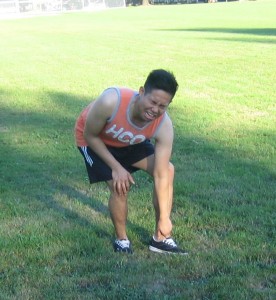Extensor tendinitis involves the inflammation of the extensor tendons which is found along the top of the foot and responsible for straightening the toes. The pain caused by this condition can be felt on the top of the foot. This occurs when the tendons or the cord-like attachments of muscles to bones is inflamed and irritated due to overuse.
Symptoms of extensor tendonitis
- Pain becomes severe when engaging in activities
- Pain with gentle stretching of the tendons
- There is bruising and tenderness when touched
- Pain becomes worse when wearing inappropriate or tight shoes as well as difficulty in walking.
Causes of extensor tendinitis

- Pain can be felt on top of the foot that becomes worse during running.
- Pain in the tendons when stretched by curling the toes and a diffuse swelling over the top of the foot.
- Overuse of the muscles
- Wearing ill-fitting shoes and shoes that are laced very tightly can cause pressure on the top of foot
- A change in the training methods especially running uphill and using the treadmill can place substantial stress on the extensor tendons found on top of the foot.
- Running downhill causes the muscle to work eccentrically and places plenty of stress on the extensor tendons and also running on slippery surfaces or on ice.
Treatment and home remedies for extensor tendonitis
- Get plenty of rest until pain is minimized. The individual should avoid engaging in physical activities in order to help with the fast healing of the condition.
- Apply an ice pack or cold compress on the affected area for 10 minutes or use ice cubes wrapped in wet tea towel or a reusable ice pack. Avoid applying ice directly to the skin since it can damage the skin.
- Once the initial painful stage has been minimized, apply heat on the affected area.
- Wear appropriate foot wear and avoid lacing the shoes too tightly since it adds direct pressure on the extensor tendons of the foot.
- Avoid wearing worn out running shoes. Running shoes are only good for 400 miles of running and should be replaced with a new pair.
- Take the prescribed anti-inflammatory medication such as naproxen and ibuprofen in order to help minimize swelling, inflammation and pain.
- Perform gentle massage while the tendon is still tender since this helps in minimizing the swelling of the foot.
- Perform regular stretching in order to help build flexibility and prevent irritation to the extensor tendons. The individual can perform wall stretches for the large gastrocnemius muscles as well as step stretches for the smaller soles muscles.
- Wear shoe inserts or orthotics to help correct the flattened arch and repair the biomechanics of the foot and leg.
If the symptoms of the condition still persist or does not heal with rest, it is time to seek medical help immediately.
